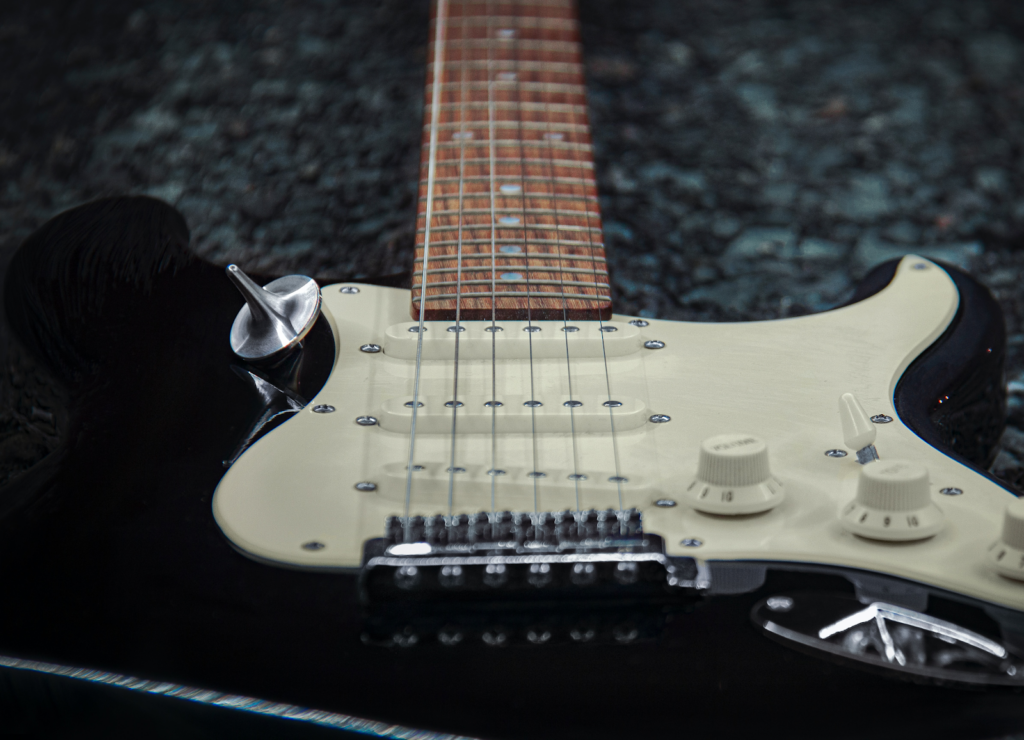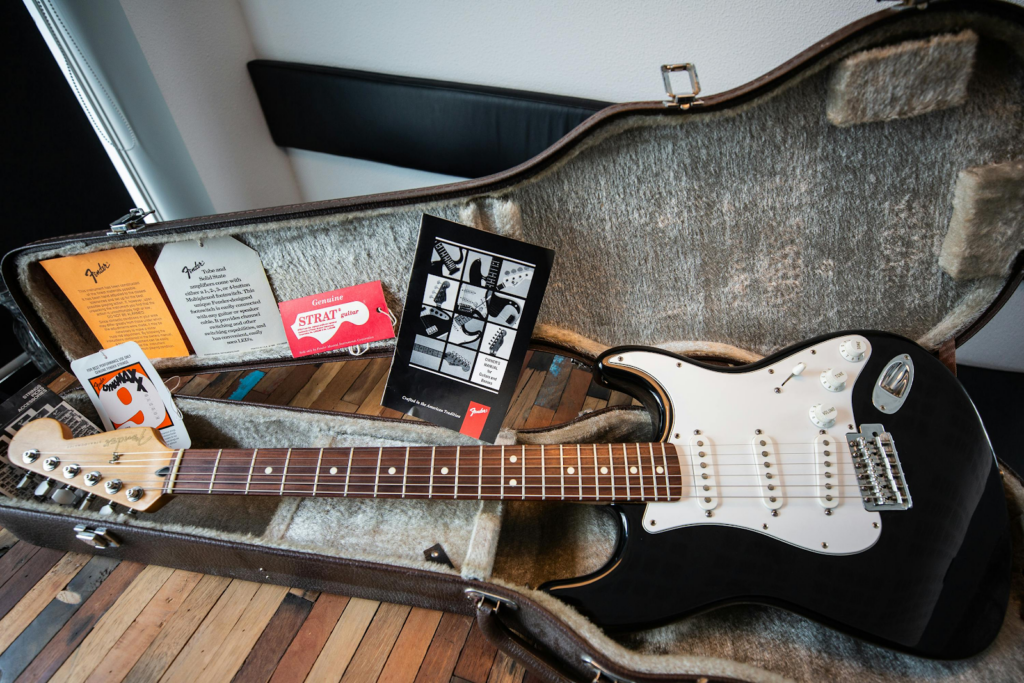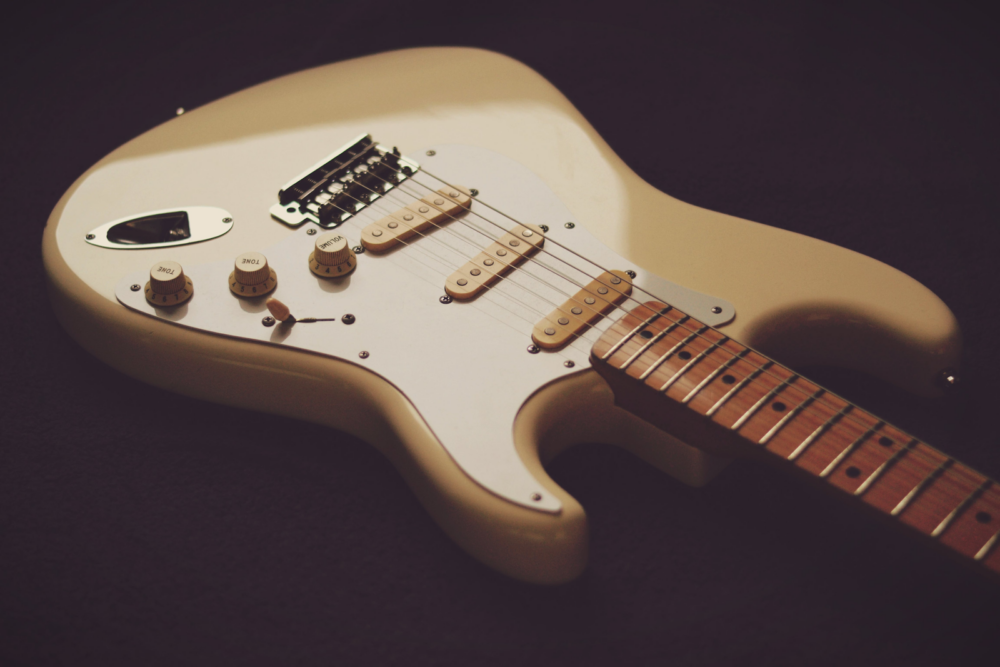When you think of electric guitars, the Strat is probably one of the first things that springs to mind. Known for its legendary sound and captivating shape, Squier – a subsidiary of Fender – offers a range of Stratocaster models that are both budget-friendly and performer-approved.
Let’s dive into eight models and see what makes each of them unique!

What is the Fender Squier Stratocaster?
When you hear the name “Stratocaster,” your mind might be conjuring up images of legendary musicians rocking out on stage with their iconic guitars. But not all Stratocasters are built equally, and this is where the Fender Stratocaster comes into play.
The Stratocaster is a brainchild of Squier, a subsidiary of the renowned Fender brand. Squier Stratocasters have found their own niche in the guitar community. They resemble their Fender siblings closely, embracing the classic three single-coil pickup configuration that has become synonymous with the Strat name.
What Makes a Squier Different From a Fender?
The differences lie beneath the surface. Stratocasters are constructed using more economical materials, such as less expensive wood varieties, pickups, and hardware components. While this does make them more affordable, it can also lead to nuanced differences in sound quality and tonal characteristics when compared to the Fender Stratocasters.
Another distinction between the two lies in their origin of manufacture. While the prestige associated with Fender Stratocasters comes partly from their manufacturing in places like Mexico, Japan, and America, Stratocasters are primarily produced in the Far East. This shift in production location, where labor costs tend to be lower, further contributes to the affordability of Squier guitars.
However, it’s essential not to dismiss Squier Strats as mere cheap versions of Fender guitars. Over the years, they have carved out a reputation for providing remarkable value for their price. These Fender Models serve as an excellent option for beginners stepping into the world of electric guitars or seasoned players seeking a reliable backup or practice instrument. Not to mention, Squier has an array of popular models under its belt, including names like the Squier Bullet Strat, Bullet Mini Strat V2, Strat SS, Vintage Modified ’70s Stratocaster, the Squier Standard Stratocaster, and the Squier Classic Vibe series.
The Fender Stratocaster stands as a testament to the fact that quality guitars don’t always have to burn a hole in your pocket. With a legacy tied to the Fender name and a commitment to affordability without sacrificing quality, the Squier Stratocaster continues to resonate with guitarists worldwide.

1. Squier Bullet Stratocaster: The Classic Reborn
For many, their first foray into the world of electric guitars is with the Squier Bullet Stratocaster. Reflecting the timeless aura of the original Stratocaster, the Squier Bullet series serves as an affordable gateway for budding musicians. It’s not just a guitar; it’s the culmination of decades of musical heritage tailored for the modern era.
Body & Build: With its thin, lightweight body, this guitar feels great in your hands and is perfect for those long jam sessions.
Neck Profile: An easy-to-play “C” shaped neck profile makes it easy for new players to get used to the feel.
Design & Hardware: Staying true to the Stratocaster’s signature look, the Squier Bullet Strat boasts a traditional double-cutaway body shape. It’s generally made of basswood or poplar, resulting in a lightweight feel. The hardtail bridge not only ensures consistent tuning stability but also simplifies string changes for beginners learning to play the electric guitar.
2. Squier Contemporary Stratocaster: Bold and Modern
When tradition meets innovation, something spectacular is born. The Contemporary Stratocaster is a testament to this fusion. Designed for musicians who walk the path less traveled, this model is a modern interpretation of the Strat, combining vintage ethos with cutting-edge features.
Pickups: Squier SQR™ traditional single-coil pickups in a “special” configuration, with the middle pickup shifted closer to the bridge for dynamic responsiveness.
Neck: The roasted maple neck is chosen for tone stability, and the sculpted heel design means you can shred right up to the 22nd fret.
Design & Hardware: This guitar screams modernity. Its unique pickup placement and stealthy black hardware, coupled with a sleek painted headstock and chrome logos, make it a visual standout. The high-performance components like the 2-point tremolo bridge and sealed-gear tuning machines further enhance its playability and tuning precision.
3. Squier Mini Stratocaster: Small Size, Big Sound
Don’t be fooled by its size! This guitar, while petite, is a powerhouse of sound. Tailored for the younger generation, travelers, or those with a penchant for compact instruments, this guitar ensures that size doesn’t compromise quality.
Compact Design: Despite its reduced size, it boasts the familiar Fender tone.
Design & Hardware: A compact version of the Strat, this guitar maintains the iconic double-cutaway design but in a scaled-down size. Despite its size, it doesn’t skimp on quality, featuring a hardtail bridge that offers excellent tuning stability, especially crucial for younger or beginner players.
4. Squier Affinity Series Stratocaster: A Blend of Legacy and Innovation
Squier Affinity guitars are trusted companions. Designed to accompany guitarists at every stage of their journey, from their first chord to their first gig, it resonates with the very essence of what makes Squier guitars iconic.
Design & Hardware: The Squier Affinity Stratocaster retains the iconic silhouette of the Strat, usually crafted from alder or poplar. Its 2-point tremolo bridge provides a smooth vibrato experience. The sealed die-cast tuning machines with split shafts ensure that your tuning remains spot-on, even after those wild solo bends.
Bridge & Tuning: This Squier guitar features a 2-point tremolo bridge and sealed die-cast tuning machines for reliable playing sessions.
5. Classic Vibe 50’s: A Nod to the Golden Age
The 1950s: An era where rock ‘n’ roll was young and the guitar reigned supreme. The Classic Vibe 50’s captures the spirit of this golden age, transporting players back to a time of jukeboxes and slicked-back hair with every strum.
Design: With Fender-designed alnico pickups, 1950s-inspired headstock markings, and a vintage-tint gloss neck finish, it’s a beautiful blast from the past.
Design & Hardware: Dripping with vintage aesthetics, the Classic Vibe 50’s features a classic alder or poplar body, complete with rich-looking nickel-plated hardware. Its vintage-tint gloss neck finish not only gives it an old-school vibe but also feels smooth to the touch, ensuring comfortable play.
6. Classic Vibe 60s: Swinging into the Past
The 60s, a decade of cultural revolution and musical evolution. The Classic Vibe 60s encapsulates this transformative period. Designed to echo the vibes of Woodstock, peace, and love, it’s a musical time machine in your hands.
Design Aspects: “C”-shaped neck profile, alnico pickups, and 1960s-inspired headstock markings bring back memories of Woodstock and peace signs.
Design & Hardware: Embracing the spirit of the 60s, this model combines the vintage allure of the Strat with modern playability. Its C-shaped neck profile with an easy-playing 9.5″ radius fingerboard ensures comfort, while the nickel-plated hardware adds a touch of old-school luxury to its design.
7. Classic Vibe 70s: Rocking the Retro
Bell-bottoms, disco balls, and the unmistakable sound of the 70s. Enter the Classic Vibe 70s, a guitar that embodies the eclectic spirit of the disco era, allowing players to groove to the retro beat.
Retro Appeal: Fender-Designed alnico pickups, 1970s-inspired headstock markings, and a vintage-tint gloss neck finish make this a favorite among retro enthusiasts.
Design & Hardware: Capturing the funk and flair of the 70s, this model showcases a classic Strat body with a distinct 70s headstock design. The easy-playing 9.5″ radius fingerboard and narrow-tall frets ensure a comfortable play, while its nickel-plated hardware complements the overall retro aesthetic.

History of the Squier Brand: From Strings to Stratocasters
The story of Squier is one of evolution, transformation, and an unyielding association with the Fender name. Before we delve into the brand’s transition into one of the most recognizable names in affordable guitars, it’s essential to understand its roots.
Origins in Craftsmanship
The Squier tale began not with guitars but with strings. V.C. Squier Company, founded in 1890 by Victor Carroll Squier in Battle Creek, Michigan, initially made its name crafting high-quality strings for violins, banjos, and guitars. Their reputation grew swiftly, and they became known for producing some of the best strings in the industry.
The Fender Connection
Fast forward to the 1960s, the booming era of rock ‘n’ roll, and the emergence of the electric guitar as an icon. Fender, already a massive name in the electric guitar industry, recognized the value in Squier’s legacy of craftsmanship and acquired the company. Initially, Fender utilized the Squier name as a means to sell their strings, but it didn’t take long for them to see a greater potential in the brand.
Enter: The Squier Guitars
By the early 1980s, Fender was facing fierce competition from high-quality, low-cost Japanese guitar imports. Recognizing a need to enter this budget market without diluting the premium Fender brand name, they turned to Squier.
In 1982, the first Squier guitars were launched in Japan—reissues of Fender’s classic models, including the iconic Stratocaster. These models boasted the Fender design but were positioned as more affordable alternatives.

Squier Stratocasters: A Legacy in the Making
As the years progressed, Squier’s line-up expanded, and production moved to other parts of Asia to keep costs down and meet growing demand. While always positioned as Fender’s “younger sibling,” Squier developed its own identity and fan base. The brand became synonymous with value, offering budding guitarists the chance to own a guitar with the Fender legacy without the hefty price tag.
From its early days producing high-end strings to its current status as a go-to brand for affordable, quality guitars, Squier’s journey is a testament to adaptation, market understanding, and the power of a strong association with a brand like Fender. Today, when we see a Stratocaster, we’re not just looking at a budget guitar; we’re witnessing a chapter in a story that spans over a century—a story of music, craftsmanship, and evolution.
In Harmony: Squier Guitars
In the vast and diverse world of guitars, few names evoke as much recognition and respect as the Stratocaster. Within that realm, Stratocasters stand as a testament to the idea that quality, legacy, and affordability can harmoniously coexist. From the earliest days of V.C. Squier Company’s string craftsmanship to the present-day Squier Strat models that grace stages, studios, and bedrooms worldwide, the journey is nothing short of inspirational.
Squier has continuously demonstrated that it’s not always about the price tag. It’s about the passion, the craft, and the countless hours of practice and performance. The Squier range is vast; whether you’re a budding guitarist picking up your first Squier Bullet or a seasoned musician exploring the unique tones of the Squier Contemporary series, there’s a Squier out there for everyone.
The intertwined histories of Fender and Squier and their shared commitment to bringing music into the lives of people across the globe ensure that the legacy of the Stratocaster—across all its models and iterations—will continue to thrive. In the end, it’s not just about wood, strings, and pickups; it’s about the stories, the songs, and the souls touched by the magic of the Stratocaster.


